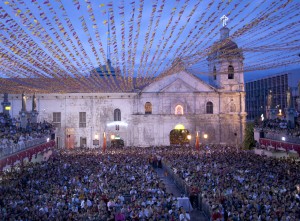Quake felt in areas far from Bohol

The Basilica De Sto. Nino (Basilica of the Holy Child) in Cebu City is seen with its bell tower gone following a 7.2-magnitude earthquake that hit Bohol and was felt as Intensity VI in Cebu city in central Philippines Tuesday Oct. 15, 2013. AP PHOTO/BULLIT MARQUEZ
MANILA, Philippines—The Philippines lies in the Pacific Ring of Fire, a chain of islands that are prone to quakes and volcanic eruptions.
As a result of the earthquake on Tuesday, Intensity VII was felt in Tagbilaran City; Intensity VI in Hinigaran, Negros Occidental, Mactan in Cebu, as well as Cebu, Dumaguete and Mandaue cities; Intensity V in Iloilo, Ozamis, Cagayan de Oro, and La Carlota cities, Guimaras Island, Abuyog town in Leyte, Sibulan town in Negros Oriental, and Gingoog City in Misamis Oriental.
Intensity IV was felt in Roxas, Masbate, Dipolog, Bacolod, Bayawan, Butuan and Tacloban cities; Bulusan town in Sorsogon; Hinunangan in Leyte; Patnungon in Antique; Tabon in Leyte; Baybay in Southern Leyte; San Pablo in Leyte; Bato, Leyte; San Jose, Antique; and Guihulngan, Negros Oriental.
Intensity III was felt in Davao, Canlaon, Cotabato, Zamboanga, Surigao and Borongan cities; as well as La Castellana town in Negros Occidental; Bukidnon province; Tarragona town in Davao; Laoan in Antique; Banisilan, North Cotabato; and the towns of Potongan, Polanco, Labason and Manukan, all in Zamboanga del Norte.

A January 2011 file photo of the facade of Basilica de Sto. Nino with its bell tower in Cebu city in central Philippines. The Tuesday earthquake toppled the bell tower of the Philippines’ oldest church. AP PHOTO/CHESTER BALDICANTOS
Intensity II was felt in Tacurong City; Nabas and Libertad towns in Aklan; as well as Carrascal, Surigao del Sur, while Intensity I was felt in Lezo town in Aklan.
Article continues after this advertisementLiquefaction
Article continues after this advertisementThe Philippine Institute of Volcanology and Seismology (Phivolcs) described an Intensity VII tremor as destructive in which most people are frightened and run outdoors.
“People find it difficult to stand in upper floors. Heavy objects and furniture overturn or topple. Big church bells may ring. Old or poorly built structures suffer considerable damage. Some well-built structures are slightly damaged. Some cracks may appear on dikes, fish ponds, road surfaces, or concrete hollow block walls. Limited liquefaction, lateral spreading and landslides are observed. Trees are shaken strongly,” Phivolcs said.
The agency defines liquefaction as a process where loose saturated sand loses strength during an earthquake and behaves like liquid.
Earthquakes measured at 7 to 8 magnitude are considered major earthquakes and can cause considerable damage near the epicenter.
Shallow-seated or near-surface major earthquakes, when they occur under the sea, may generate tsunamis.
Phivolcs Director Renato Solidum told the Inquirer that the last strong earthquake recorded in Bohol was on Feb. 8, 1990, which was measured at 6.8 magnitude and its epicenter located 17 kilometers east of Tagbilaran City.
Phivolcs records showed the quake caused “ground fissures, landslides, rockfalls, ground subsidence and collapse, sand or mud fountaining and sudden increase on the sea level. Most of the manifestations were particularly observed and experienced by the towns of Jagna, Valencia, Duero, Guindulman and Garcia Hernandez.
“The force of the incoming waves from the sea caused Alijuan River in Duero to flow inland immediately after the earthquake.”
RELATED STORY:
Bohol quake felt in much of Mindanao
newsinfo.inquirer.net/507207/bohol-quake-felt-in-much-of-mindanao